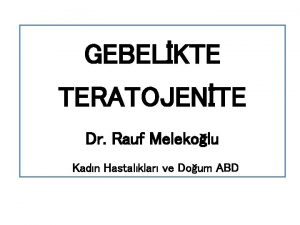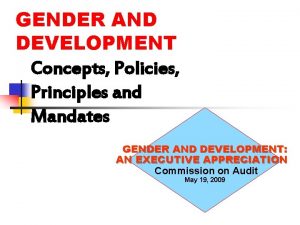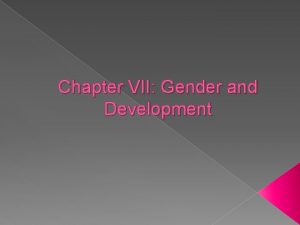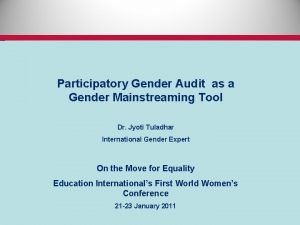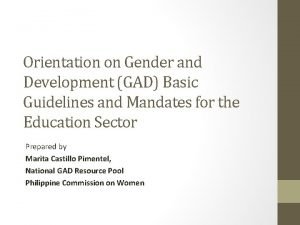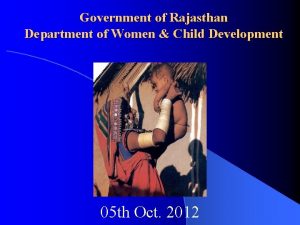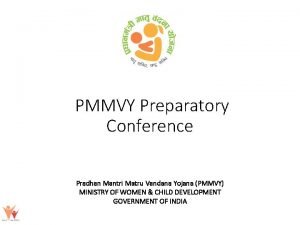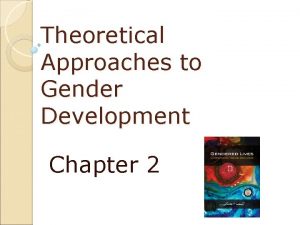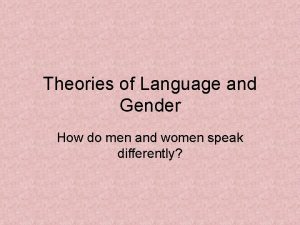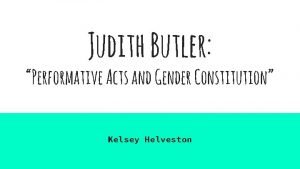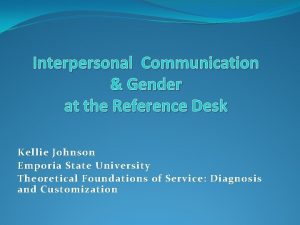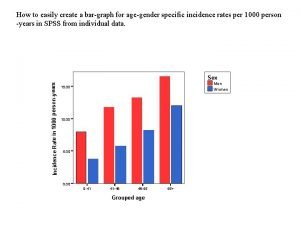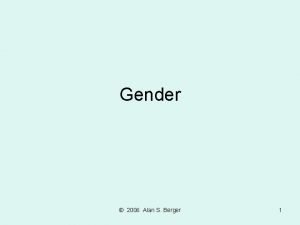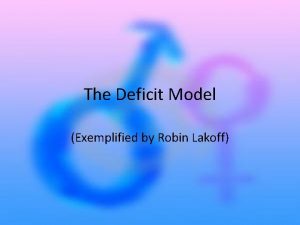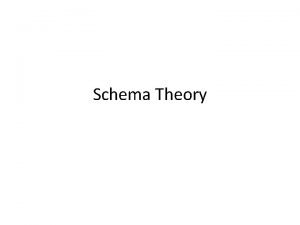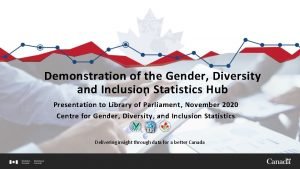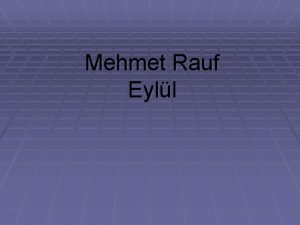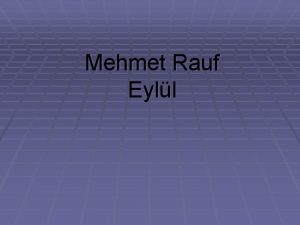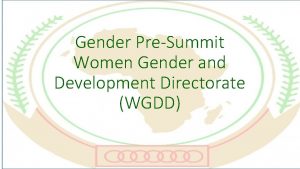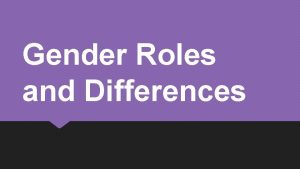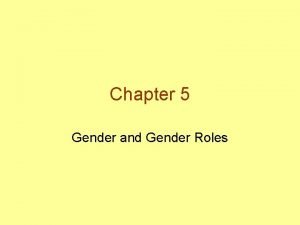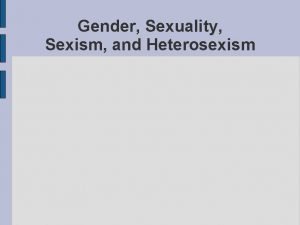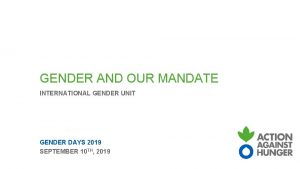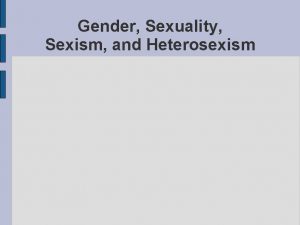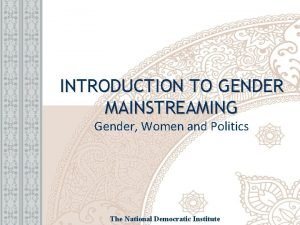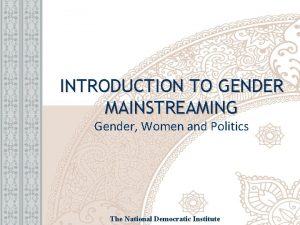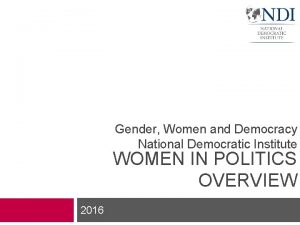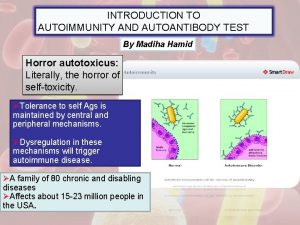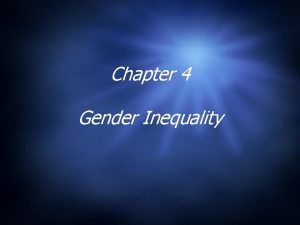Women in Development Gender and Development Madiha Rauf






























- Slides: 30

Women in Development & Gender and Development Madiha Rauf Hashmi

Contents 1. Concept of Development 2. Feminist’s view and development 3. Indicator of Development 4. Women in development Approach 5. Critism on WID 6. Gender and development 7. Critism on GAD 8. Some milestone

Two Major Development Approaches • Women in Development • Gender and Development

Concept of Development The term “development” is usually used in an exclusively economic sense by government and international organizations. In defining development, it is vital to include the human element because structures alone have no meaning unless they transform the lives of the people who use or depend on them. Further more, when including the human element, gender must be analyzed in order to assess the particular needs of both men and women. So it can be said that development is the movement from a simple or worse situation to a sophisticated and better situation.

Cont…. . American economist Professor Michael Todaro (1977) sees three objectives of development: • Producing more 'life sustaining' necessities such as food, shelter, and health care and broadening their distribution • Raising standards of living and individual’s self esteem • Expanding economic and social choice and reducing fear. This statement puts participation of the citizenry at the centre of development Amartya Sen (1981) in his work, Development as Freedom, States that development is the expansion of capabilities leading to enrichment of human lives. This, he argues, is only possible if the people have the freedom to choose between different ways of thinking, the ability to choose how they want to live.

Definition of Development • “Development is a dynamic process of improvement, which implies a change, an evolution, growth and advancement. Development as a phenomenon suggests that people are able to control their future and can improve their condition in the world (living conditions, capacity to feed, education level and life length , etc. ) through process towards something better”(Skeldon R. , 1997).

Measures of Development UN’s Human Development index (HDI): Measures a country’s average achievements in three basic dimensions 1. Life expectancy. 2. Educational attainment. 3. Adjusted real income.

Indicators of Gender • Gender disparities in development can be captured by using the Gender-related development index (GDI) and the gender empowerment measure (GEM). • The Gender-related Development Index (GDI) and the Gender Empowerment Measure (GEM) were introduced in 1995 in the Human Development Report written by the United Nations Development Program. These measures can be used to rank countries in order of achievements on gender equality, rather than just on human development, as with the Human Development Index (HDI).

Cont… GDI: Calculated by looking at 3 variables (same as HDI) • Education as measured by school enrollment and adult literacy • Wealth as measured by GNI per capita adjusted for purchasing power parity • Health as measured by life expectancy at birth GEM: Calculated by looking at 3 variables • Political participation and decision making • Economic participation and decision making • Control over economic resource

Cont…. • GDI focuses on the impact of gender inequality on human development. • The GEM measures gender inequality in key areas of economic and political participation and decision making, such as seats held in parliament, and percentage of managerial positions held by women. The GEM thus differs from the GDI, which is an indicator of gender inequality in basic capabilities (UNDP, 1995: 39). • Higher GDP does not guarantee greater gender equality. (UNDP , 1995 , 2005 &2007)

World Economic Forums Gender Equality Measure • WEF attempt to measure gender equality in five areas, economic participation, economic opportunity, political empowerment, educational attainment and health and wellbeing (Lopez-Claros, A. & Zahidi, S. 2005. )

Background of WID The term ‘women in development' came into use in the early 1970 s, after Ester Boserup’s publication on “Women’s Role in Economic Development”. Boserup analyzed the changes in traditional agricultural practices as societies modernized and examined the differential impacts of the changes in work done by men and women. She highlighted the following points in Women’s Role in Economic Development (1970), a comparative analysis of women’s work : • Women’s labour at home and on the farm generally under-reported. • Highlighted the negative impacts of colonialism and the penetration of capitalism. To improve women’s education, employment, political representation, their participation in social welfare is emphasized.

Women in Development Approach • WID first came to prominence in the early 1970 s as an approach to include women in development. • WID perspective was developed by American liberal feminists. • It was reaction to women being seen as passive beneficiaries of development. • WID (Women in Development) concept is based on recognition of the importance of the roles and status of women in development process.

Cont…. . • Prime characteristic of Women in Development approach was the emphasis on bringing women of the developing world into the economic sphere. • Different policy responses and interventions focused on women as a separate group resulting in women’s concerns being added on and peripheral to mainstream development efforts. WID policies and interventions concentrated on women’s productive work. • Focus on the better integration of women into existing development initiatives.

Features of WID • It highlighted the fact that women need to be integrated into development processes as active agents if efficient and effective development is to be achieved. • Women’s significant productive contribution was visible, although their reproductive role was downplayed. . • Women’s subordination was seen in the terms of their exclusion from the market sphere, and limited access to and control over resources. • Programs informed by a WID approach addressed women’s practical needs by, for example ü creating employment ü income-generating opportunities ü improving access to credit and to education.

Different Sub-approaches of WID Equity Approach Anti-poverty Approach Efficiency Approach

WID Approaches • Equity: Focus on equality between women and fair distribution of benefits of development • Anti-poverty: Women targeted as the poorest of the poor, with emphasis on income generating activities and access to productive resources such as training and micro-finance. • Efficiency: Emphasis on need for women’s participation for success, effectiveness of development; assumes increased economic participation will result in increased equity. They are most likely to be useful when advocacy for the advancement of women is based on the more effective use of all factors of production, and/or desire for stronger and more sustainable project results (Kaan, 2007).

Criticism on WID • WID focuses only on women and does not address the unequal gender relations in various social and economic settings • It ignores the reproductive role of women. • WID approach begins from an acceptance of existing social structures.

Cont. . . • The WID approach focuses on integrating women into the development without questioning the kind of development that was being fostered by the donor nations from the industrialized countries. • It focuses on women as a unit of analysis without recognizing the important divisions and relations of exploitation.

Shift over from WID to GAD • The GAD approach seeks to understand women’s subordination through analysis of the relation between men and women within the framework of important and relevant factors like social class, race and age etc. • The shift from a focus on women in isolation, to a focus on gender, ensures a more comprehensive view of the co-operation and conflict between women and men.

Why shift was needed? • Development was to be done on bases of differences between men and women • Lack of progress of WID policy • Imbalance of power • “Women need development “ was replaced “Development needs women”.

The Development of GAD Origins: GAD emerged in the 1980 s from feminist critiques of successful development models put forward by the major development agencies. Influenced by socialist feminist thinking. Focus : • Gender analysis of social relations and structures. • Holistic perspective looking at all aspects of women’s lives • Condition and position of men and women • Practical and strategic gender interests. • Structural changes and legislations

Features of GAD A strategy that is designed to enable gender concerns to be built into the analysis, planning, and organization of development policies, programs, and projects. An approach that seeks to promote equality between the sexes through the empowerment of women and men in the population and in development activities An approach that values equality in all areas in which there are major gaps between men and women, notably in: - The division of labour; - Access to services and resources; - Control of resources and benefits; - Decision-making power.

Cont…. An approach that does not focus solely on women or on men, but rather on transforming the relationships(Power relations) between the genders in a more egalitarian sense. An approach that tries to broaden women’s participation at every level. An approach that is not designed to turn women into men, but rather to make sure that access to resources is not tied to belonging to one sex or the other. It emphasizes the state’s duty to provide social services in promoting women’s emancipation. Women seen as agents of change rather than as passive recipients of development assistance.

WID and GAD Approaches: The paradigm shift Sr. No WID GAD 1 The Focus Women Gender Relation 2 The Problem Exclusion of women from the development process Unequal power relation 3 The Goal Efficient and effective development Equitable and sustainable development with women and men in decision making 4 The Solution Integrate women into Empower the disadvantaged the development process and women 5 The Strategies Women’s projects , increasing women’s income and ability to look after the household Address practical and strategic gender needs identified by men and women

Difference Between WID and GAD WID GAD Works with women in women’s projects Works with both men and women Works within the biological roles Focus at the social structure Welfare oriented and limited to specific short term interventions Empowerment oriented Isolates the women Mainstream gender by involving both Does not question the status quo Challenge the Status quo Maintain Women’s traditional roles and status quo Critically examines patriarchal relations, gender division of labour and gender disparities

Criticism on GAD Critiques from the South • Some of the sharpest criticism of GAD and its originator has come from women in the South, arguing that they reflect the preoccupations and assumptions of Western feminists. ‘Third World’ women are ‘homogenised’ and treated as ‘victims’ of their own cultures, negating their agency. These critics argue instead that their subordination is a consequence of colonial exploitation rather than the cultural construction of gender in their own societies (Sen and Grown 1987) • Role and involvement of males are ill-defined

Some Milestones Actions for WID and GAD FAO • 1989 -1995 First Plan of Action : Integration of Women in development • 1996 -2001 Second Plan of Action : Women in Development (WID) • 2002 -2007 Third Plan of Action : Gender and Development (GAD) • 2008 -2013 GAD Action Plan

UN 1975 First World Conference on Women (WCW) 1975 -1985 UN Decade for Women 1985 1990 1995 2000 Second WCW – Nairobi - Forward-Looking Strategies (NFLS) Third WCW - Copenhagen – Mid-Term Review Fourth WCW - Beijing – Beijing Platform for Action United Nations General Assembly - Special Session – Beijing + 5

THANK YOU
 Madiha
Madiha Madiha anas
Madiha anas Strategic gender needs and practical gender needs
Strategic gender needs and practical gender needs Paradigm shift from women studies to gender studies
Paradigm shift from women studies to gender studies Shayan rauf
Shayan rauf Rauf melekoğlu
Rauf melekoğlu Rauf melekoğlu
Rauf melekoğlu Wal hamdu lillahi rabbil 'alamin
Wal hamdu lillahi rabbil 'alamin Dr rauf
Dr rauf Preeklampsi tanı kriterleri
Preeklampsi tanı kriterleri Gad objectives
Gad objectives Objectives of gender and development
Objectives of gender and development Gender roles and identity
Gender roles and identity Gender and development
Gender and development Sample lesson plan in gender and development
Sample lesson plan in gender and development What is wad in gender
What is wad in gender Women and child development department rajasthan
Women and child development department rajasthan Ministry of women and child development logo
Ministry of women and child development logo Theoretical approaches to gender development
Theoretical approaches to gender development Language and gender
Language and gender Snow white male version
Snow white male version Gender-neutral housing pros and cons
Gender-neutral housing pros and cons Butler theory
Butler theory Gender interpersonal communication
Gender interpersonal communication Gender graph
Gender graph Gender stratification
Gender stratification Female deficit model example
Female deficit model example Schemas in memory
Schemas in memory Dynamic approach language and gender
Dynamic approach language and gender Centre for gender diversity and inclusion statistics
Centre for gender diversity and inclusion statistics What is the study of communication, gender and culture
What is the study of communication, gender and culture






